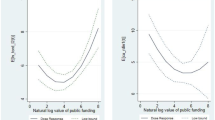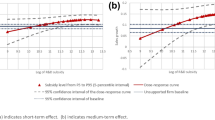Abstract
Most small and medium enterprises (SMEs) in Korea struggle in financing R&D. Thus, the Korea Core Industrial Technology Investment Association (KITIA) was established to implement a matching fund program (MFP) to help SMEs with this undertaking. Applicant firms to the MFP are reviewed first based on their technology levels and are required to attract financing from venture capitalists (VCs), before receiving funds from the MFP. This paper, based on KITIAs MFP applicant data from 2001 to 2004, evaluates the performance of the MFP in terms of the success rate of funded SMEs’ initial public offerings (IPOs) and bankruptcy rates in relation to those SMEs that could not attract matching funds. Propensity score matching was used to eliminate selection bias from the data in order to assess the actual treatment effect of the MFP. According to the result of logistic regression applied to the matched data, MFP apparently did not have significant effects on IPO success and bankruptcy. This implies that MFP needs to allow VCs more time to evaluate SMEs covering qualitative aspects as well. It is expected that this change of structure can provide better performance of MFP in terms of IPO success and bankruptcy of matched SMEs.
Similar content being viewed by others
References
Balcaen, S., Manigart, S., Buyze, J., & Ooghe, H. (2011). Firm exit after distress differentiating between bankruptcy, voluntary liquidation and M&A. Small Business Economics. 39, 949–975. doi:10.1007/s11187-011-9342-7.
Berkovitch, E., & Israel, R. (1998). The bankruptcy decision and debt contract renegotiations. European Finance Review, 2, 1–27.
Chang, S. J. (2004). Venture capital financing, strategic alliances, and the initial public offerings of Internet startups. Journal of Business Venturing, 19, 721–741.
Chava, S., & Jarrow, R. A. (2004). Bankruptcy prediction with industry effects. Review of Finance, 8, 537–569.
D’Aveni, R. A., & MacMillan, I. C. (1990). Crisis and the content of managerial communications a study of the focus of attention of top managers in surviving and failing firms. Administrative Science Quarterly, 35(4), 634–657.
Demers, E. A., & Joos, P. (2007). IPO failure risk. Journal of Accounting Research, 45, 1–50.
Eisdorfer, A., & Hsu, P. H. (2009). Innovate to survive: The effect of technology competition on corporate bankruptcy, working paper, University of Connecticut.
Engel, D., & Keilbach, M. (2007). Firm-level implications of early stage venture capital investment: An empirical investigation. Journal of Empirical Finance, 14(2), 150–167.
Feller, I. (2000). Social contracts and the impact of matching fund requirements on American Research Universities. Educational Evaluation and Policy Analysis, 22(22), 91–98.
Florin, J. (2005). Is venture capital worth it? Effects on firm performance and founder returns. Journal of Business Venturing, 20, 113–135.
Greening, D. W., & Johnson, R. A. (1996). Do managers and strategies matter? A study in crisis. Journal of Management Studies, 33(1), 25–51.
Haeussler, C., Harhoff, D., Mueller, E. (2009). To be financed or not…—The role of patents for venture capital financing. Discussion papers 253, SFB/TR 15 Governance and the Efficiency of Economic Systems, Free University of Berlin, Humboldt University of Berlin, University of Bonn, University of Mannheim, University of Munich.
Halliday, T. C., Powell, M. J., & Granfors, M. W. (1987). Minimalist organizations: vital events in the state bar associations: 1870–1930. American Sociological Review, 52(4), 456–471.
Heckman, J., Ichimura, H., & Todd, P. (1998). Matching is an econometric evaluation estimator. Review of Economic Studies, 65, 261–294.
Hellmann, T. (2000). Venture capitalists: The coaches of silicon valley. In C.-M. Lee, W. F. Miller, M. G. Hancock & H. S. Rowen (Eds.), The silicon valley edge: A habitat for innovation and entrepreneurship. Stanford: Stanford University Press.
Hellmann, T., & Puri, M. (2002). Venture capital and the professionalization of start-up firms: Empirical evidence. Journal of Finance, 57, 169–197.
Hsu, D. H., & Ziedonis, R. H. (2007). Patents as quality signals for entrepreneurial ventures. Copenhagen: Paper presented at the DRUID Summer Conference 2007.
Jain, B. A., & Kini, O. (1999). The life cycle of initial public offering firms. Journal of Business Finance and Accounting, 26, 1281–1307.
Kaplan, S. N., Sensoy, B. A., & Stromberg, Per. (2009). Should investors bet on the jockey or the horse? Evidence from the evolution of firms from early business plans to public companies. Journal of Finance, 64, 75–115.
Kaplan, S. N., & Stromberg, P. (2001). Venture capitalists as principals: Contracting, screening, and monitoring. The America Economic Review, 91(2), 426–430.
Kim, Y. H., & Heshmati, A. (2006). Analysis of Korean IT start-up’s initial public offering and their post-IPO performance. Journal of Productivity Analysis, 34(2), 133–149.
Lechner, M. (2001). Identification and estimation of causal effects of multiple treatments under the conditional independence assumption. In M. Lechner & F. Pfeiffer (Eds.), Econometric evaluation of labour market policies. Heidelberg: Physica/Springer.
Lemmon, M., Ma, Y. Y., & Tashjian, E. (2009). Survival of the fittest? Financial and economic distress and restructuring decisions in Chapter 11. Singapore: Paper presented at the Third Singapore Conference on Finance.
Lerner, J. (1994). The importance of patent scope: an empirical analysis. RAND Journal of Economics, 25, 319–333.
Lerner, J. (1999). The government as venture capitalist: The long-run impact of the SBIR program. Journal of Business, 72(3), 285–318.
Maksimovic, V. & Phillips, G. (1997). Asset efficiency and reallocation decisions of bankrupt firms, working paper, University of Maryland.
Mann, R. J., & Sager, T. W. (2007). Patents, venture capital, and software start-ups. Research Policy, 36, 193–208.
Megginson, W. L., & Weiss, K. A. (1991). Venture capitalist certification in initial public offerings. Journal of Finance, 56, 879–903.
Moon, T. H., & Sohn, S. Y. (2010). Technology credit scoring model considering both SME characteristics and economic conditions: The Korean case. Journal of the Operational Research Society, 61, 666–675.
Murray, G. C., & Marriott, R. (1998). Why has the investment performance of technology-specialist, European venture capital funds been so poor? Research Policy, 27(9), 947–976.
Ooghe, H., Joos, P., & De Bourdeaudhuij, C. (1995). Financial distress models in Belgium: The results of a decade of empirical research. The International Journal of Accounting, 30(3), 245–274.
Ooghe, H., & Waeyaert, N. (2004). Oorzaken van faling: literatuuroverzicht en conceptueal Verklarings model. Economisch en Sociaal Tijdschrift, 57, 367–393.
Pompe, P. P. M., & Bilderbeek, J. (2005). The prediction of bankruptcy of small and medium-sized industrial firms. Journal of Business Venturing, 20(6), 847–868.
Rosenbaum, P., & Rubin, D. (1983). The central role of the propensity score in observational studies for causal effects. Biometrika, 70, 41–55.
Sahlman, W. A. (1990). The structure and governance of venture-capital organizations. Journal of Financial Economics, 27, 473–521.
Shane, S., & Stuart, T. (2002). Organizational endowments and the performance of university start-ups. Management Science, 48, 154–170.
Sohn, S. Y., & Heo, I. S. (2010). What do venture capitalists consider important when evaluating ventures to match a government support fund?. Seoul: Technical Report Yonsei University.
Stuart, T. E., Hoang, H., & Hybels, R. C. (1999). Interorganizational endorsements and the performance of entrepreneurial ventures. Administrative Science Quarterly, 44, 315–349.
Timothy, R. D. (2009). The rise and fall of the participating securities SBIC program: Lessons in public venture capital management. Perspectives In Public Affairs School Of Public Affairs Arizona State University, 6(spring), 51–68.
Van Gelderen, M., Bosma, N., & Thurik, R. (2006). Success and risk factors in the pre-startup phase. Small Business Economics, 26(4), 319–335.
Wang, C. C., Wang, K., & Lu, Q. (2003). Effects of venture capitalists’ participation in listed companies. Journal of Banking & Finance, 27, 2015–2034.
Westhead, P., & Storey, D. J. (1997). Financial constraints on the growth of high technology small firms in the United Kingdom. Applied Financial Economics, 7(2), 197–201.
Wu, W. (2007). Cultivating research universities and industrial linkages in China: The case of Shanghai. World Development, 35(6), 1075–1093.
Zacharakis, A. L., & Meyer, G. D. (2000). The potential of actuarial decision models: can they improve the venture capital investment decision? Journal of Business Venturing, 15, 323–346.
Author information
Authors and Affiliations
Corresponding author
Rights and permissions
About this article
Cite this article
Heo, I.S., Sohn, S.Y. & Ji, E.J. Effects of the matching fund program on IPO and bankruptcy of SMEs in Korea. Small Bus Econ 42, 117–129 (2014). https://doi.org/10.1007/s11187-012-9467-3
Accepted:
Published:
Issue Date:
DOI: https://doi.org/10.1007/s11187-012-9467-3
Keywords
- Matching fund program (MFP)
- Venture capital
- IPO
- Bankruptcy
- Propensity score matching (PSM)
- Logistic regression
- KITIA
- SMEs




